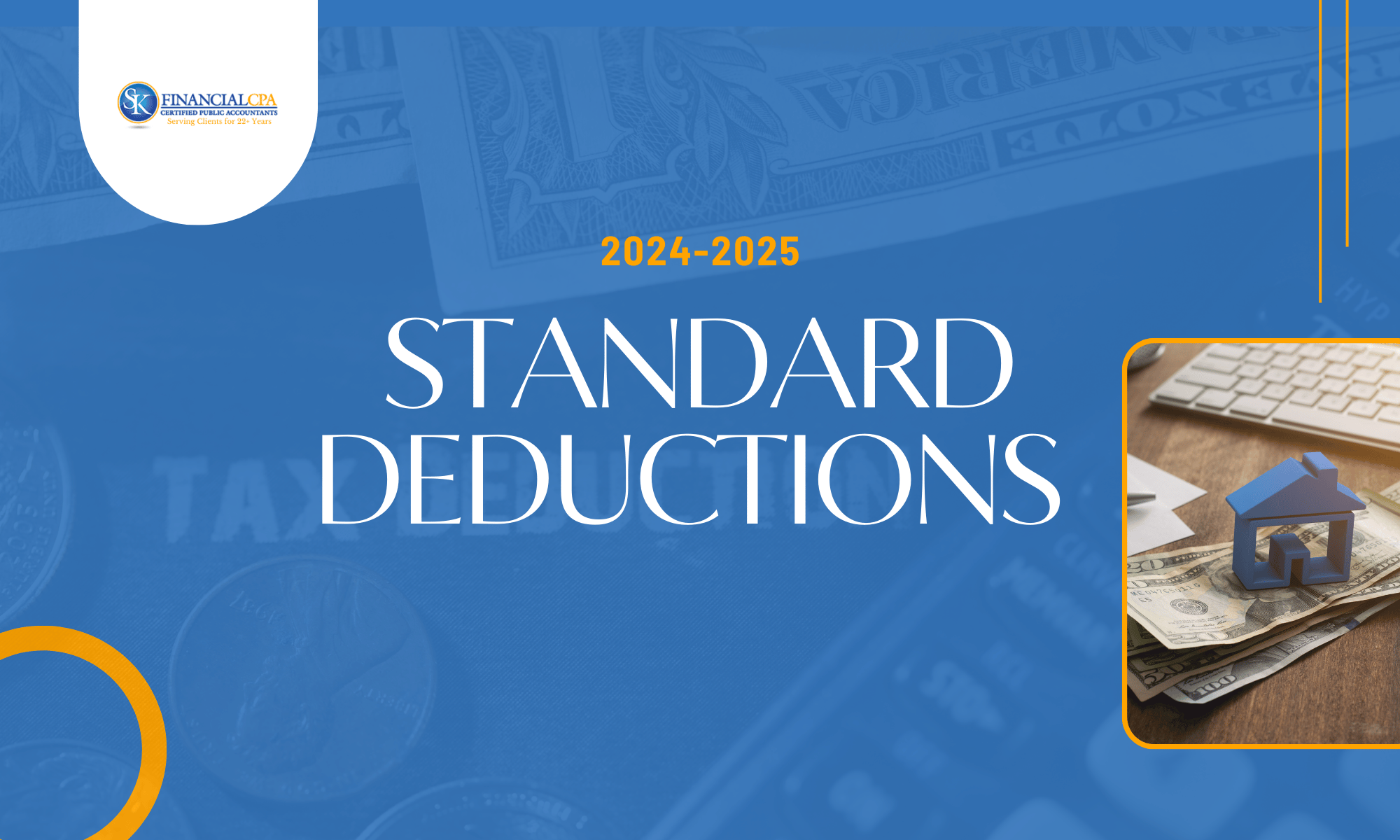
Standard Deduction 2024-2025: Amounts, Eligibility When to Take It
When tax season rolls around, one question most taxpayers have is how they can reduce their tax liability without over-complicating their returns. One of the easiest ways to lower your taxable income is through the standard deduction. Let’s take a closer look at the standard deduction for the 2024 and 2025 tax years, why it’s important, and how it can work to your benefit.
2024 standard deduction for tax returns filed in 2025 is $14,600 for single filers, $29,200 for joint filers or $21,900 for heads of household.
What is the Standard Deduction?
The standard deduction is a fixed amount that reduces the income subject to federal income tax, making tax filing simpler for most people. Instead of tracking every deductible expense like charitable contributions, mortgage interest, or medical bills, you can take this single deduction to instantly lower your taxable income. It’s an efficient way to simplify the tax process while still benefiting from significant tax savings. For many taxpayers, especially those without substantial deductible expenses, the standard deduction eliminates the need to itemize and ensures they don’t miss out on potential tax breaks. Each year, the IRS adjusts the standard deduction to account for inflation, ensuring it remains valuable as living costs rise.
Read more about standard deduction 2023-2024
Standard Deduction for 2024
For the 2024 tax year, the standard deduction amounts are $14,600 for single filers, $29,200 for married couples filing jointly, $21,900 for heads of household, and $14,600 for married individuals filing separately. These figures represent a modest increase from the previous year, reflecting the IRS’s effort to keep up with inflation. The standard deduction is particularly beneficial for taxpayers who don’t have enough deductible expenses to justify itemizing. For example, if you’re a single filer with an adjusted gross income (AGI) of $60,000, taking the $14,600 deduction would reduce your taxable income to $45,400, potentially lowering your tax bracket and saving you hundreds of dollars in taxes.
| Filing Status | 2024 Standard Deduction |
| Single | $14,600 |
| Married Filing Jointly | $29,200 |
| Head of Household | $21,900 |
| Married Filing Separately | $14,600 |
learn more about Head of household
Standard Deduction for 2025
In 2025, the standard deduction will see another slight increase due to inflation adjustments. Single filers can deduct $15,000, married couples filing jointly can deduct $30,000, heads of household can deduct $22,500, and married individuals filing separately can deduct $15,000. These increases ensure that taxpayers continue to benefit from a fair baseline deduction that keeps pace with rising costs. For instance, a married couple over 65 could add an additional $3,200 to their $30,000 standard deduction, bringing their total deduction to $33,200.
|
Filing Status |
2025 Standard Deduction |
|
Single |
$15,000 |
|
Married Filing Jointly |
$30,000 |
|
Head of Household |
$22,500 |
|
Married Filing Separately |
$15,000 |
This consistent increase reflects the IRS’s effort to keep the deduction valuable as costs rise. These adjustments ensure that taxpayers have a fair baseline deduction to reduce their taxable income effectively.
Example: How the Standard Deduction Lowers Your Taxable Income
Imagine you’re filing as a single taxpayer in 2024 with an adjusted gross income (AGI) of $60,000. Here’s how the standard deduction affects your taxable income and ultimately your tax bill:
-
AGI: $60,000
-
2024 Standard Deduction (Single): -$14,600
-
Taxable Income After Deduction: $45,400
This $14,600 deduction reduces the income on which you’ll pay taxes, potentially lowering your tax bracket and decreasing your overall tax bill. The difference between taking the deduction and not could mean hundreds of dollars saved in taxes, depending on your bracket.
What is the extra standard deduction for seniors over 65 in 2024 and 2025?
The IRS recognizes that seniors and the legally blind may have higher medical costs and fewer earning years. To help, they offer an additional standard deduction that adds extra tax-saving power to the standard amount.
|
Filing Status |
2024 Additional Deduction |
2025 Additional Deduction |
|
Single or Head of Household |
+$1,950 |
+$2,000 |
|
Married Filing Jointly/Separately |
+$1,550 per qualifying individual |
+$1,600 per qualifying individual |
For example, a single filer over 65 in 2024 would see their deduction increase from $14,600 to $16,550. Married couples where both spouses are over 65 can add $3,100, totaling $32,300 in standard deductions. These additions can make a significant impact, especially for retirees on fixed incomes.
How Does the Standard Deduction Benefit Different Types of Taxpayers?
The standard deduction is designed to provide tax relief to a wide range of taxpayers, regardless of their filing status. Single filers benefit from a straightforward reduction in taxable income, while married couples filing jointly enjoy double the deduction amount, giving them a significant advantage. Heads of household receive an enhanced deduction to reflect their role in supporting dependents, and seniors or blind individuals qualify for additional deductions to offset higher medical costs.
For example, a single filer over 65 in 2024 can claim an extra $1,950, raising their deduction from $14,600 to $16,550. These adjustments ensure that the standard deduction remains a valuable tool for reducing tax liability across different taxpayer groups.
Learn more about Married Filing Jointly vs Separately
Standard Deduction Trends Over Recent Years
Let’s take a look at how the standard deduction has evolved. The IRS has consistently raised this deduction amount to keep up with the cost of living.
|
Tax Year |
Single |
Married Filing Jointly |
Head of Household |
Married Filing Separately |
|
2021 |
$12,550 |
$25,100 |
$18,800 |
$12,550 |
|
2022 |
$12,950 |
$25,900 |
$19,400 |
$12,950 |
|
2023 |
$13,850 |
$27,700 |
$20,800 |
$13,850 |
|
2024 |
$14,600 |
$29,200 |
$21,900 |
$14,600 |
|
2025 |
$15,000 |
$30,000 |
$22,500 |
$15,000 |
These increases show the IRS’s commitment to offering a tax break that keeps up with rising costs, allowing taxpayers to retain more of their income.
Learn more about income tax brackets
Deciding Between the Standard Deduction and Itemizing
Choosing between the standard deduction and itemizing depends on your individual financial situation. If your deductible expenses such as mortgage interest, charitable donations, and medical bills are low or nonexistent, the standard deduction is likely your best option. It offers simplicity and eliminates the need to track receipts or documentation. However, if you’re a homeowner with high mortgage interest, pay significant state or local taxes, or make large charitable contributions, itemizing might save you more money. For example, if your itemizable deductions total $18,000 and the standard deduction is $14,600, itemizing would reduce your taxable income further. SK Financial CPA recommend running the numbers both ways to ensure you’re making the most of your tax savings.
IRS releases tax inflation adjustments for tax year 2025
Special Considerations for Dependents
Dependents filing their own tax returns can also benefit from the standard deduction, but the amount is typically lower.
|
Tax Year |
Dependent Minimum Deduction |
Earned Income Plus |
|
2024 |
$1,300 |
Earned Income + $450 |
|
2025 |
$1,350 |
Earned Income + $450 |
Dependents who file their own tax returns also qualify for a standard deduction, though the amount is typically lower than for other filers. For 2024, dependents can claim either $1,300 or their earned income plus $450, whichever is higher, but not exceeding the standard deduction for their filing status. In 2025, this minimum deduction rises slightly to $1,350. This provision is particularly helpful for young workers or students who are claimed as dependents on someone else’s return. While their deduction may be smaller, it still provides a meaningful tax break, allowing them to keep more of their earnings without needing to itemize deductions.
When NOT to Take the Standard Deduction
While the standard deduction is a great option for most taxpayers, there are specific scenarios where it may not be the best choice. For example, nonresident aliens are generally ineligible for the standard deduction unless covered by a tax treaty. Similarly, trusts, estates, and partnerships cannot claim the standard deduction and must rely on itemized deductions or other strategies to reduce taxable income. Additionally, taxpayers with a short tax year due to changes in accounting periods are also ineligible. In these cases, alternative strategies like itemizing deductions or claiming specific tax credits can help minimize tax liability. Consulting a tax professional can ensure that ineligible taxpayers still maximize their allowable benefits.
When to Claim the Standard Deduction
The standard deduction is often the best choice for taxpayers who want a simple and hassle-free filing process. It’s ideal if you have few itemizable expenses, aren’t a homeowner, or don’t incur high medical costs. Seniors and blind individuals benefit even more, as they qualify for additional deductions that boost their total savings. Dependents also find the standard deduction advantageous since they typically lack the expenses needed to itemize. Plus, you won’t need to worry about keeping receipts or documentation, which can save time and reduce stress during tax season. Ultimately, the standard deduction is a powerful tool for simplifying your taxes while still maximizing your savings.
Conclusion
The standard deduction is a cornerstone of the U.S. tax system, offering a straightforward way to reduce taxable income and simplify the filing process. Whether you’re a retiree, dependent, or homeowner, understanding how the standard deduction works can help you save money and avoid unnecessary complications. At SK Financial CPA, we’re here to guide you through the decision-making process and ensure you choose the option that maximizes your tax savings. Contact us today for personalized advice tailored to your unique financial situation.
FAQs
Q1: What is the standard deduction?
Ans: The standard deduction is a fixed amount that reduces your taxable income, making tax filing simpler. Instead of tracking every deductible expense (like charitable contributions or mortgage interest), you can take this single deduction to lower your tax bill. For 2024, it ranges from $14,600 for single filers to $29,200 for married couples filing jointly.
Q2: How much is the standard deduction for 2025?
A: For 2025, the standard deduction will increase slightly due to inflation adjustments. Single filers can deduct $15,000, married couples filing jointly can deduct $30,000, heads of household can deduct $22,500, and married individuals filing separately can deduct $15,000.
Q3: Can I claim both the standard deduction and itemized deductions?
Ans: No, you must choose one or the other. You cannot claim both the standard deduction and itemized deductions on the same tax return. Most taxpayers opt for the standard deduction because it’s simpler, but itemizing may save you more money.
Q4: Who qualifies for the additional standard deduction for seniors?
Ans: Taxpayers who are 65 or older or legally blind qualify for an additional standard deduction. For 2024, single filers or heads of household can add $1,950, while married filers can add $1,550 per qualifying individual. This extra deduction helps retirees and those with higher medical costs reduce their taxable income further.
Q5: What happens if I’m claimed as a dependent?
Ans: If someone else claims you as a dependent, your standard deduction is limited. For 2024, dependents can claim either $1,300 or their earned income plus $450, whichever is higher but not exceeding the standard deduction for their filing status. In 2025, the minimum deduction rises slightly to $1,350.
Q6: Are nonresident aliens eligible for the standard deduction?
Ans: Generally, no. Nonresident aliens are ineligible for the standard deduction unless a tax treaty between the U.S. and their home country allows it. They may need to itemize deductions or explore other tax strategies to reduce their taxable income.
Q7: Can trusts, estates, or partnerships claim the standard deduction?
Ans: No, trusts, estates, and partnerships are ineligible for the standard deduction. Instead, they must rely on specific deductions related to their financial activities, such as administrative expenses or fees. Individual partners or beneficiaries may claim deductions on their personal returns.
Q8: What happens if I have a short tax year?
Ans: Taxpayers with a short tax year are ineligible for the standard deduction. In such cases, they may need to itemize deductions or prorate certain expenses to accurately reflect their financial situation during the shorter tax period.
Follow SKFinancial on Facebook / Twitter / Linkedin / Youtube for updates.












